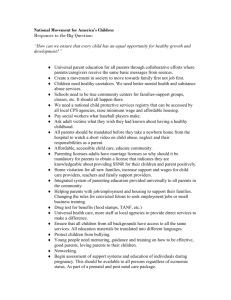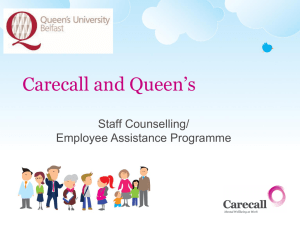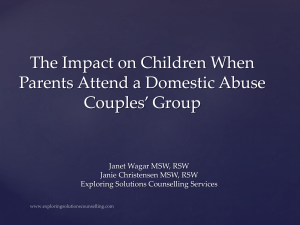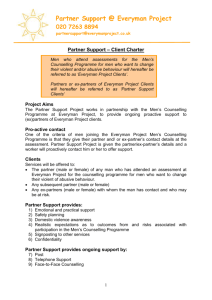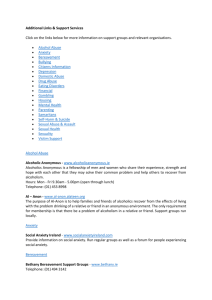Sample Common Outcomes Survey
advertisement
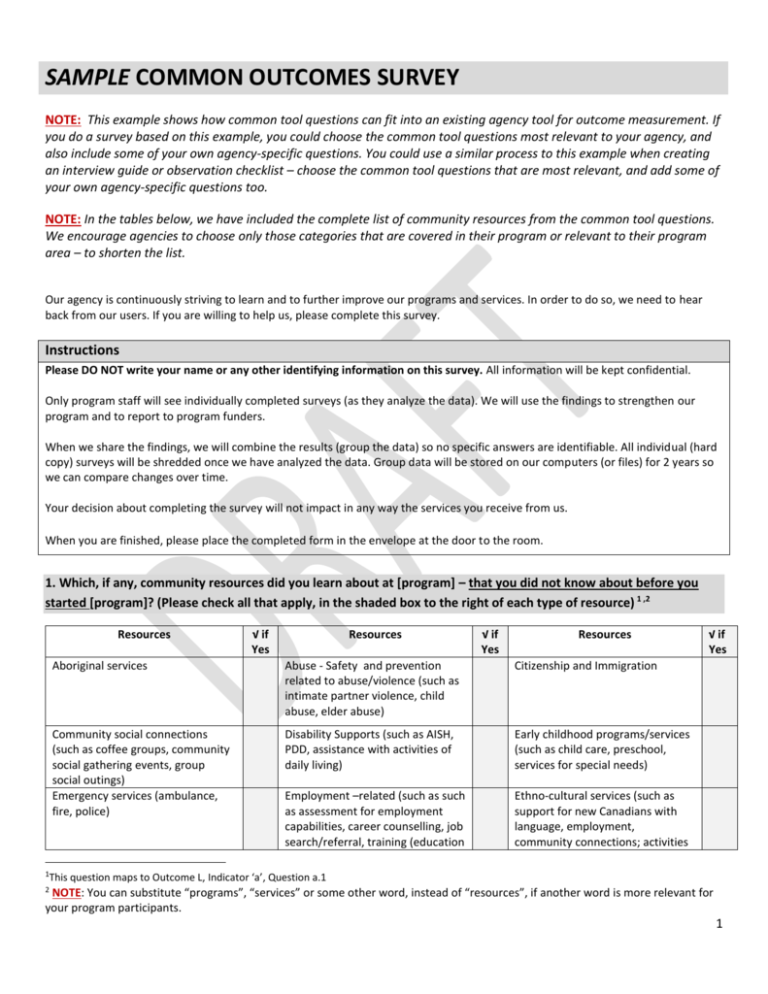
SAMPLE COMMON OUTCOMES SURVEY NOTE: This example shows how common tool questions can fit into an existing agency tool for outcome measurement. If you do a survey based on this example, you could choose the common tool questions most relevant to your agency, and also include some of your own agency-specific questions. You could use a similar process to this example when creating an interview guide or observation checklist – choose the common tool questions that are most relevant, and add some of your own agency-specific questions too. NOTE: In the tables below, we have included the complete list of community resources from the common tool questions. We encourage agencies to choose only those categories that are covered in their program or relevant to their program area – to shorten the list. Our agency is continuously striving to learn and to further improve our programs and services. In order to do so, we need to hear back from our users. If you are willing to help us, please complete this survey. Instructions Please DO NOT write your name or any other identifying information on this survey. All information will be kept confidential. Only program staff will see individually completed surveys (as they analyze the data). We will use the findings to strengthen our program and to report to program funders. When we share the findings, we will combine the results (group the data) so no specific answers are identifiable. All individual (hard copy) surveys will be shredded once we have analyzed the data. Group data will be stored on our computers (or files) for 2 years so we can compare changes over time. Your decision about completing the survey will not impact in any way the services you receive from us. When you are finished, please place the completed form in the envelope at the door to the room. 1. Which, if any, community resources did you learn about at [program] – that you did not know about before you started [program]? (Please check all that apply, in the shaded box to the right of each type of resource) 1 ,2 Resources √ if Yes Resources √ if Yes Resources Aboriginal services Abuse - Safety and prevention related to abuse/violence (such as intimate partner violence, child abuse, elder abuse) Citizenship and Immigration Community social connections (such as coffee groups, community social gathering events, group social outings) Emergency services (ambulance, fire, police) Disability Supports (such as AISH, PDD, assistance with activities of daily living) Early childhood programs/services (such as child care, preschool, services for special needs) Employment –related (such as such as assessment for employment capabilities, career counselling, job search/referral, training (education Ethno-cultural services (such as support for new Canadians with language, employment, community connections; activities √ if Yes 1 This question maps to Outcome L, Indicator ‘a’, Question a.1 2 NOTE: You can substitute “programs”, “services” or some other word, instead of “resources”, if another word is more relevant for your program participants. 1 Resources √ if Yes Resources √ if Yes or on-the-job) Financial counselling/money management (such as budgeting, banking) Health (such as family doctor, dental care, eye care, public health centre, health information health benefits/coverage available for people with low incomes) Legal or protective services (such as Legal Aid, child protection, restraining orders ) Parenting programs or information (such as child growth and development, healthy parenting strategies, dealing with child behaviour issues, family functioning) Relationship support (such as counseling, healthy decision making) Transportation Resources √ if Yes to connect people with same cultural background, cross-cultural activities) Functional assessments (such as development, skills, behaviours) Food (multiple food groups – including fruits and vegetables – from sources such as food bank, community kitchen, good food box, community garden) Housing supports (such as affordable housing options, rent supplements, landlord-tenant information) Income Supports (such as SFI) Libraries Places of worship/spiritual support Schools Mental health/emotional support (such as counselling, practical supports for daily living as needed) Recreation/leisure (facilities, programs, groups for people with common hobbies or interests, sports or physical activity groups) Shopping assistance/advice (such as sources of affordable food, clothing, household goods, toys) None of these Other (please specify) 2. Which kinds of resources, if any, have you used in the [insert timeframe of interest]? Which ones were helpful to your needs? (Please check all the kinds of resources you used, in the light gray shaded box to the right of each type of resource. Please check which kinds were helpful, in the dark gray shaded box.)3 Resource Aboriginal services Community social connections (such as coffee groups, community social gathering events, group social outings) Emergency services (ambulance, fire, police) √ if Used √ if Help Resource √ if Used √ if Help Resource Abuse - Safety and prevention related to abuse/violence (such as intimate partner violence, child abuse, elder abuse) Disability Supports (such as AISH, PDD, assistance with activities of daily living) Citizenship and Immigration Employment –related (such as such as assessment for Ethno-cultural services (such as support for new Canadians with √ if Used √ if Help Early childhood programs/services (such as child care, preschool, services for special needs) 3 The first part of this question maps to Outcome E, Indicator ‘b’, Question b.2. The second part of this question maps to Outcome E, Indicator ‘c’, Question c.1 2 Resource √ if Used √ if Help Resource employment capabilities, career counselling, job search/referral, training (education or on-the-job) Financial counselling/money management (such as budgeting, banking) Health (such as family doctor, dental care, eye care, public health centre, health information health benefits/coverage available for people with low incomes) Legal or protective services (such as Legal Aid, child protection, restraining orders ) Food (multiple food groups – including fruits and vegetables – from sources such as food bank, community kitchen, good food box, community garden) Housing supports (such as affordable housing options, rent supplements, landlord-tenant information) Libraries Parenting programs or information (such as child growth and development, healthy parenting strategies, dealing with child behaviour issues, family functioning) Relationship support (such as counseling, healthy decision making) Places of worship/spiritual support Transportation Other (please specify) Schools √ if Used √ if Help Resource √ if Used √ if Help language, employment, community connections; activities to connect people with same cultural background, cross-cultural activities) Functional assessments (such as development, skills, behaviours) Income Supports (such as SFI) Mental health/emotional support (such as counselling, practical supports for daily living as needed) Recreation/leisure (facilities, programs, groups for people with common hobbies or interests, sports or physical activity groups) Shopping assistance/advice (such as sources of affordable food, clothing, household goods, toys) None of these 3 3. How much do you agree or disagree with the following statement: I know at least one place in the community where I can turn to when I need help (such as someone to listen, give advice). (Please circle the number that best reflects what you think)4,5 Strongly disagree 1 Disagree 2 Neither agree/ disagree 3 Agree 4 Strongly agree 5 4. Where do you turn when you need advice or support, compared to when you started [program]?6 Prompts (as needed): People? Places? Community resources? Reasons for turning to these sources of support? How did you learn about them? How were these sources helpful? NOTE: Agency-specific questions can be added. 5. Any other comments? Please write them here. Thank you for completing this survey! 4 This question maps to Outcome D, Indicator ‘b’, Question b.1 5 This is a slightly different format that you will see in the document of common outcomes, indicators and tools. That is OK, as the response categories are still the same. 6 This question maps to Outcome D, Indicator ‘b’, Question b.5 4

